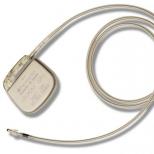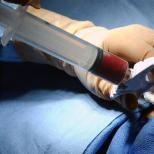Pericardial puncture: vital and therapeutic and diagnostic indications
There are strict indications for pericardial puncture. Any intervention in the cardiac region is risky, so this procedure is performed in life-threatening conditions. Medicine knows both therapeutic and diagnostic purposes of the puncture of the pericardial sac.
The human heart continuously maintains the movement of blood through the arteries and veins. The main role in the implementation of this function is played by the heart muscle (myocardium), which performs rhythmic contractions.
The heart is a fibromuscular hollow organ that provides blood flow through the blood vessels through repeated rhythmic contractions.
Thanks to these contractions, blood is transported from the lungs to oxygenation and to all tissues of the body. In addition, the heart, as a pump, continuously pumps out the already used blood from the organs and sends it back to the alveoli of the lungs.
The right and left parts of the heart are functionally different - one part is involved in blood oxygenation, the other delivers blood with oxygen to all parts of the body.
The heart is not just freely located among other organs of the chest cavity - it is covered with a connective tissue bag, the pericardium. The pericardium forms a cavity between its serosa and the muscle membrane of the heart, where it produces a small amount of fluid to prevent tissue friction.
Some diseases lead to inflammation of the sheets of the pericardium, due to which the serous cells begin to secrete much more fluid. A similar process occurs due to a chest injury with damage to the pericardial sac, however, in this case, the pericardial cavity is filled with blood. All this leads to a violation of the contractility of the heart.
Vital indications for pericardial puncture
Vital indications are certain critical conditions of the body that require immediate medical attention. The only vital indication for pericardial puncture is cardiac tamponade.

When performing a puncture of the pericardium, it is necessary to take into account the indications and contraindications
Cardiac tamponade is a violation of the contractile work of the heart, due to the accumulation of excess fluid in the pericardial sac.
This condition can lead to death if medical assistance is not provided to the person in a timely manner.
With cardiac tamponade, effusion, exudate, or pus accumulate in the pericardium. The accumulation of blood in the pericardial sac is called hemopericardium. If a liquid has formed without the participation of inflammation, then this is the so-called hydropericardium.
Cardiac tamponade occurs in a number of cases:
- Gunshot wounds or stab wounds to the chest.
- Blunt chest trauma in a car accident.
- Accidental perforation of the pericardium during medical and diagnostic procedures.
- Punctures made during central venous catheterization.
- Cancer that has spread to the pericardial sac.
- Violation of the integrity of the aortic aneurysm.
- Pericarditis.
- Systemic lupus erythematosus is an autoimmune disease.
- Exposure to high level radiation.
- Hypothyroidism.
- Heart failure.
- Renal failure.
- Infections affecting the heart.
In all these cases, pericardial puncture is in the nature of urgent care. Often, the procedure must be carried out in the first minutes after the onset of tamponade, only to deliver the patient alive to the hospital.
Therapeutic and diagnostic indications for pericardial puncture
In many cases, a pericardial puncture performs a dual function - it removes a physical barrier to heart contraction and diagnoses the disease. A common indication in this case is pericarditis.
Pericarditis is an inflammation of the layers of the pericardial sac. Pathology is accompanied by excessive release of fluid into the pericardial cavity, which can lead to the cardiac tamponade described above.

Cardiac tamponade is a disease of the pericardium characterized by the accumulation of effusion (fluid) between the connective tissue of the cavity in the outer lining of the heart called the pericardium.
Actually tamponade is a therapeutic indication for pericardial puncture. The diagnostic indication is associated with the need for a laboratory study of exudate (liquid). Often it is both therapeutic and diagnostic.
Causes of pericarditis:
- Idiopathic diseases.
- Viral and bacterial infections.
- Systemic autoimmune and inflammatory disorders.
- Metabolic disorders - renal failure, hypothyroidism.
- Cardiovascular disorders - the consequences of a heart attack, Dressler's syndrome and aortic dissection.
- Other causes are iatrogenic, oncological, narcotic.
Diagnostic indications
Diagnostic indications are reduced to the need to confirm the presence of fluid or blood in the pericardium, as well as to take a sample of exudate for laboratory testing. In such cases, pericardial puncture is performed according to the Larrey or Marfan method, as these are the safest and least traumatic methods.
Thus, pericardial puncture allows doctors to simultaneously confirm the disease and alleviate the person's condition.
From this video you can learn more about pericardial puncture:





